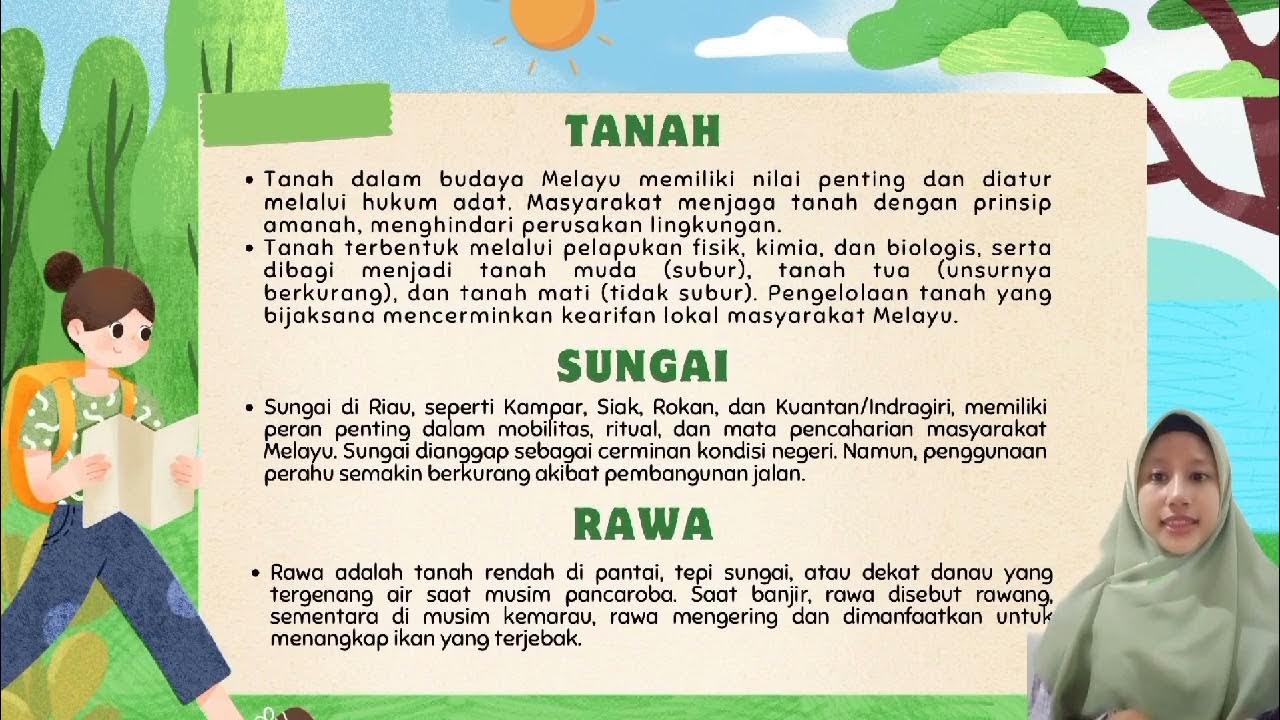Materi IPS Dinamika Interaksi Manusia - SMP Kelas 7 | Part.1
Summary
TLDRThis video explores the relationship between humans and the natural environment, showcasing how humans interact with natural elements like rivers, forests, and animals. It explains the distinction between biotic (living) and abiotic (non-living) elements, and how they influence each other. The script highlights human evolution from hunting and farming to industrialization, emphasizing both positive and negative impacts on the environment, such as pollution. The video concludes by illustrating how human activities still rely on natural conditions, such as farming during the rainy season or fishing in clear weather, to ensure safety and success.
Takeaways
- 😀 Humans interact with the natural environment in various ways, such as through fishing and farming, to fulfill daily needs.
- 🌱 The natural environment consists of both biotic (living) and abiotic (non-living) elements.
- 🌍 Biotic elements include humans, plants, and animals, while abiotic elements include water, soil, air, rocks, and rain.
- ⚖️ There is a reciprocal relationship between biotic and abiotic elements; for example, plants (biotic) can produce oxygen (abiotic), and abiotic factors like soil, temperature, and rainfall can affect plants.
- ⏳ Human activity has evolved from hunting and gathering to farming, livestock raising, and eventually industrial economies to meet the growing demand for goods.
- 💡 As societies developed, humans started to use the natural environment not only for basic needs but also for luxuries such as clothing, housing, and vehicles.
- ⚠️ Excessive production of goods can lead to negative environmental impacts, including land, water, and air pollution.
- 🌊 Land pollution occurs due to the improper disposal of waste, which can harm the environment and human health.
- 💨 Water pollution can result from industrial waste, and air pollution is largely caused by smoke from factories, vehicles, and other industrial activities.
- 🌾 Despite human control over natural resources, certain activities like farming still depend on natural conditions such as rainfall, clear weather, and avoiding disaster-prone areas.
Q & A
What is the natural environment?
-The natural environment is an environment that is formed naturally, without human intervention. It includes elements like rivers, lakes, seas, mountains, forests, and other features that are used to fulfill daily human needs.
What are the two main components of the natural environment?
-The two main components of the natural environment are biotic and abiotic elements. Biotic elements include living things like humans, plants, and animals, while abiotic elements are non-living things such as water, soil, rocks, air, and rain.
How do abiotic and biotic elements influence each other?
-Abiotic elements, such as soil, temperature, and rainfall, affect biotic elements like plants. For example, soil quality and rainfall can influence plant growth. On the other hand, biotic elements, like green plants, produce oxygen, which is part of the abiotic environment and can improve air quality.
How did early humans interact with the natural environment?
-In ancient times, humans relied on the natural environment for basic needs. They hunted animals and gathered fruits in the wild. Over time, they shifted to farming and livestock raising to secure food and settle in one place.
What changes occurred in human society over time in relation to the natural environment?
-As society developed, humans transitioned from hunting and farming to industrial economies. This shift allowed for mass production of goods and the creation of industries to meet the increasing needs of the growing population.
How did human activity evolve from using natural resources for basic needs to fulfilling lifestyle desires?
-Initially, humans used nature primarily for basic needs like food and shelter. As society progressed, people began using natural resources to fulfill lifestyle desires, such as creating luxurious clothes, buildings, and vehicles.
What negative impacts can arise from excessive production of goods?
-Excessive production of goods can lead to negative environmental impacts such as land, water, and air pollution. For example, industrial waste can pollute water sources, and factory emissions can cause air pollution, threatening human health and the environment.
What is an example of land pollution caused by human activities?
-Land pollution occurs when excessive waste and garbage are disposed of carelessly, contaminating the land. This can result from industries producing goods in large quantities without proper waste management.
Why is it important for farming to be done during the rainy season?
-Farming during the rainy season is important because plants require water to grow. Without adequate rainfall, farming may not be successful, as crops depend on water from the natural environment to thrive.
How do humans adapt to natural conditions when engaging in activities like fishing or farming?
-Humans adapt to natural conditions by timing their activities according to the environment. For example, fishermen go to sea only when the weather is clear to avoid storms, and farmers rely on the rainy season to ensure their crops receive enough water.
Outlines

هذا القسم متوفر فقط للمشتركين. يرجى الترقية للوصول إلى هذه الميزة.
قم بالترقية الآنMindmap

هذا القسم متوفر فقط للمشتركين. يرجى الترقية للوصول إلى هذه الميزة.
قم بالترقية الآنKeywords

هذا القسم متوفر فقط للمشتركين. يرجى الترقية للوصول إلى هذه الميزة.
قم بالترقية الآنHighlights

هذا القسم متوفر فقط للمشتركين. يرجى الترقية للوصول إلى هذه الميزة.
قم بالترقية الآنTranscripts

هذا القسم متوفر فقط للمشتركين. يرجى الترقية للوصول إلى هذه الميزة.
قم بالترقية الآنتصفح المزيد من مقاطع الفيديو ذات الصلة

Manusia dan Agama: Pembelajaran Berharga dari Kehidupan Hewan

Kelas XI. Biosfer dan Karakteristik Bioma

Aspectos naturais da África - Brasil Escola

Kel 2. Alam dan kearifan ekologis Melayu

Manusia dan Agama: Hubungan Manusia dan Agama

19-10 Microarray / DNA Chip - Part 1 (Cambridge AS A Level Biology, 9700)
5.0 / 5 (0 votes)
